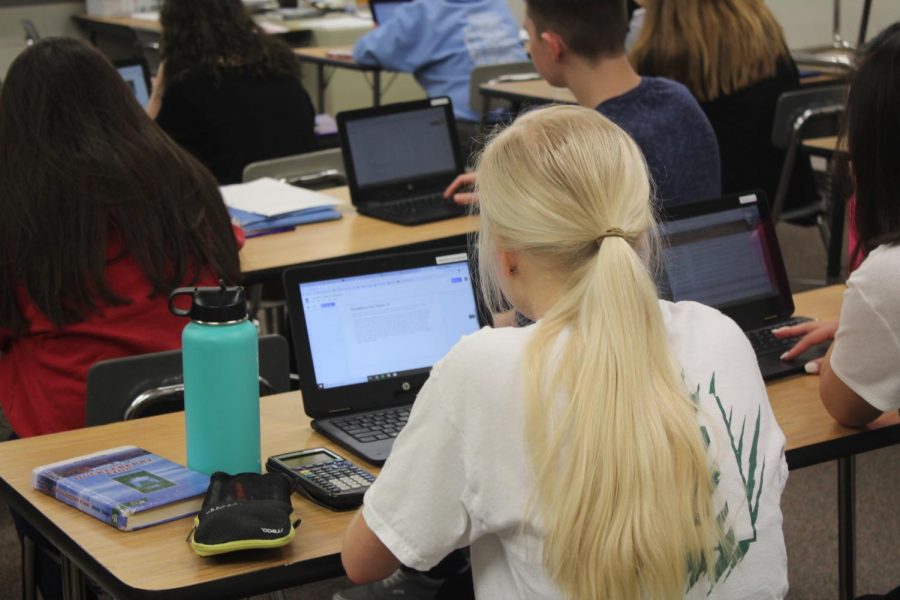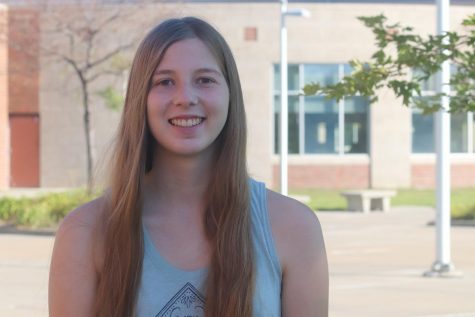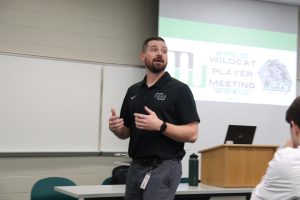Introducing blended learning
Students and staff prepare to introduce new curriculum
April 17, 2019
Whether it’s typing up a paper at Panera, collaborating on group work at a friend’s house or planning out a project at home, staff have gotten more creative with different styles of learning. Beginning in the 2019-2020 school year, Millard West has been planning to incorporate a new style of education into the curriculum called blended learning. The purpose of a unique course like this is to provide an opportunity to experiment with technology and online courses that haven’t been possible in the past. These blended learning courses will be available to all soon to be seniors interested in signing up for one of three courses: College Algebra, College Writing and U.S. Government & Economics.
The key difference between a normal course and a blended learning course is that the latter will focus on completing independent work outside of the typical classroom sessions. Blended learning courses will have fewer in-class sessions per week and more online work than a typical class, resembling how most college courses work. Several students, like junior Sydney Frerichs, are able to see the perks of these specially designed courses.
“You can spend more time teaching yourself because it’s more independent,” Frerichs said. “It depends on the class and I don’t think I’d be able to do it in a class like math, but I’d be interested in taking the U.S. Government & Economics class.”
It’s been a concept debated for a while, but not all students learn in the same manner, which is why principal Dr. Greg Tiemann is arranging to pilot this new type of curriculum.
“We’ve been planning this since last fall,” Tiemann said. “It’s in our district goal to provide an enhanced opportunity to those who don’t take interest in a traditional classroom setting.”
The idea originally came from Naperville North High School in Illinois. They were the first high school to try blended learning courses in the 2017-2018 school year. When the district observed how well students enjoy learning in this setting, it became more of a priority to make blended learning happen.
College Writing teacher Lauren McKenzie, College Algebra teacher Brent Kelderman and U.S. Government & Economics teacher Alyssa Watson have been preparing to introduce blended learning to Millard West in the upcoming school year. Teachers are first observing how blended learning works by participating in a trial course themselves.
“We are currently working on the development of our course structures with Metro Community College,” McKenzie said. “Our training involves our participation in a blended learning course, structured like our courses will be. We have assignments and a variety of tasks to complete before our next in-person session.”
While this may seem similar to the recently incorporated E-Learning Program introduced this past winter, there are several distinct differences.
First, E-Learning currently takes the place of classroom days after all planned snow days have been used. Blended learning is planned to take place for the half a year gap that regular core classes take up. In addition, students will get a grade in blended learning classes like they would in any other class.
There are still some minor issues that need to be worked out when it comes to signing up for more challenging blended learning courses, according to junior Sophie Hill.
“I’m a fan of blended learning in regular classes,” Hill said. “But next year I’m taking several AP classes. With AP classes, you need the interaction with the teacher because the material they teach in AP classes is more challenging.”
There are several new factors that blended learning will bring to the table.
“I would say that I am most looking forward to helping my students get exposure to the online, blended format,” Kelderman said. “I’m also helping the district as we venture into these types of classes and the position they will have in our district in the future.”
There are several benefits to taking a blended learning course as a senior that these students could apply to college.
“I’m eager to see students more in-charge of their own learning,” McKenzie said. “I facilitate, but they must use the tools provided to produce their own success. Whether in-person or online, learning is the responsibility of the student, while instructing, modeling and communicating expectations and content are my responsibility.”
In addition to responsibility, blended learning will also teach students about time management skills and introduce them to how true online courses work. Blended learning isn’t for everyone. It involves a large amount of trust between students and teachers when it comes to completing assignments. Students must take the initiative to get the most out of a blended learning course. It’s up to the student to come in and see the teacher if they don’t understand the material, even if they have the day off, which could be a downside, according to junior Evan Kluch.
“I’ve always just learned better in a classroom,” Kluch said. “I sometimes have trouble with independent work. It would be nice to be able to leave, but I just feel like learning works best in a classroom. It’s worked well like this for so many years so I think it’s important we keep it this way.”
While some might find it concerning piloting a new online-based class, most staff members don’t seem too worried.
“We are always cautious,” Tiemann said. “Nothing substitutes face-to-face learning between a student and a teacher. They’ll still get this opportunity about three times a week. At the end of the day, we still need human interaction between the learner and the teacher. Some classes wouldn’t work too well online anyway.”
Classes like math could prove challenging to some that already struggle with maintaining their grades in a normal classroom environment. Other courses such as College Writing involve more independent review.
Students have more freedom to use the online material as they please with blended learning. Studying could be done in the school library, at home or even at Panera with a group of friends.
“I’m hoping that students will take blended learning courses for the right reasons,” Tiemann said. “Not because they want an open campus, but because they’re ready to take on the responsibility and independence to try a new system they may like better.”
Registration for blended learning ended April 15th. Only one of the three courses may be selected by each student in order to leave room for others interested in trying the new type of curriculum. Staff may also choose to incorporate more of these classes if they work well at Millard West, but won’t be replacing face-to-face learning all together.







